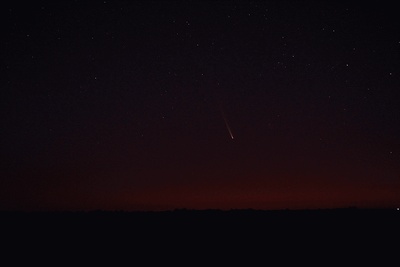Comet Tsuchinshan-Atlas is heading for Earth
Yesterday, Comet Tsuchinshan-ATLAS (C/2023 A3) made its closest approach to the sun. Now, its heading for Earth.

View of comet C/2023 A3 Tsuchinshan-ATLAS over Lake Boga, Victoria, Australia on Perihelion Day 2024 September 27.7UT. Visual estimate using 8x40mm binoculars was 2.8, with 7 degrees of tail. Naked eye visible but not conspicuous, yet. All that will change over the next couple of weeks when, on October 12, the comet has an Earth approach of 70 million kms (0.43AU).
Mattiazzo's time-lapse shows how minutes matter. The comet rises just before the sun. As it climbs out of low clouds and haze, the surrounding sky brightens rapidly. Actually seeing the comet with the human eye requires a lucky combination of altitude and waning darkness.
"Using 8x40mm binoculars, I estimate its magnitude was +2.8 with 7 degrees of tail," says Mattiazzo. "It was naked-eye visible, but not yet conspicuous. This will change over the next couple of weeks when, on Oct. 12, the comet has an Earth approach of only 70 million kms (0.43 AU)," he adds.
Comet Tsuchinshan-ATLAS could become very bright indeed. On Oct. 9th, it will pass between Earth and the sun. Sunlight will be forward scattered by comet dust, amplifying the comet's brightness to negative magnitudes. If the most optimistic predictions ( m < -5.0) come true, it could be visible even in broad daylight like Comet McNaught in 2007.
more images: from Yuri Beletsky of Las Campanas Observatory, Chile; from Ian Griffin of Mount John, South Island, New Zealand; from Jordi L. Coy of Santa Pola, Alicante, Spain; from Eduardo Schaberger Poupeau of Rafaela, Provincia de Santa Fe, Argentina;